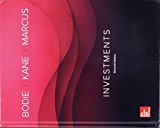
a
To compute: The payoff and the profit for investments when the call option’s exercise price X=$145 assuming that the stock price on the expiration date is $150.
Introduction:
Options: Options are the instruments used in financial transactions. These are derived based on the value of the underlying assets. Normally, the purpose of an option is to provide the buyer an opportunity to buy or sell the underlying asset depending upon the type of contract they possess. There are two types of options- Call option and put option.
a
Answer to Problem 5PS
The call buyer will incur loss of -$0.18 when the exercise price is $145.
Explanation of Solution
The information given to us is as follows:
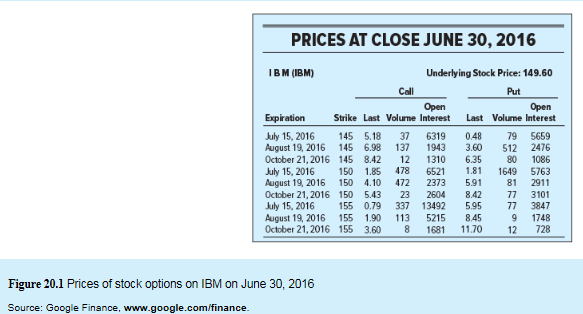
Let us calculate the payoff when Call option X is $145 and stock price on expiry date is $150.
| Calculation of payoff in case of call option | ||
| Position | Stock price > X | Stock price is less than or equal to X |
| Payoff to call holder | Stock price -X | 0 |
| Payoff to call writer | -(Stock price -X) | 0 |
Stock price at expiration is $150.
Exercise or Strike price X=$145.
So, let us now substitute the values in the above table. We get
| Calculation of payoff in case of call option | ||
| Position | Stock price > X | Stock price is less than or equal to X |
| Payoff to call holder |  | 0 |
| Payoff to call writer |  | 0 |
By the above calculation, it is observed that the call writer is prepared to bear the risk in return of option premium as there is loss if stock price increases.
Calculation of profit for investment:

But as per the information given to us, the price of the call option is $5.18 at a strike price $145 on June 2016.

Therefore, the call buyer will incur loss of -$0.18.
b.
To compute: The payoff and the profit for investments when the put option’s exercise price X=$145 assuming that the stock price on the expiration date is $150.
Introduction:
Payoff: In financial terminology, payoff refers to the
b.
Answer to Problem 5PS
The loss incurred by the put buyer will be -$0.48 when the exercise price is $145.
Explanation of Solution
The information given to us is as follows:
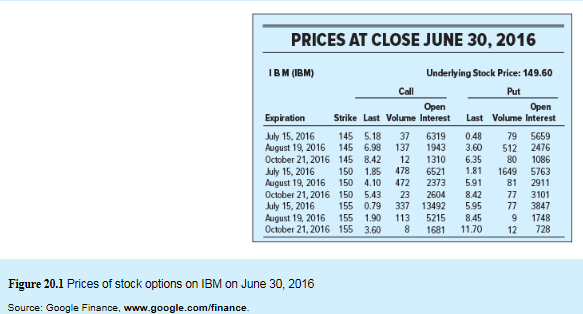
Let us calculate the payoff when Put option X is $145 and stock price on expiry date is $150.
| Calculation of payoff in case of a put option | ||
| Position | If Stock price is less than X | If Stock price is greater or equal to X |
| Payoff to Put holder | X-Stock price | 0 |
| Payoff to Put writer | -(X-Stock price) | 0 |
Stock price at expiration is $150.
Exercise or Strike price X=$145.
So, let us now substitute the values in the above table. We get
| Calculation of payoff in case of a put option | ||
| Position | If Stock price is less than X | If Stock price is greater or equal to X |
| Payoff to Put holder | $0 | 0 |
| Payoff to Put writer | $0 | 0 |

But, we are informed that the put option is $0.48 at a strike price of $145 on June2016.

Therefore, the loss incurred by the buyer on put option will be -$0.48.
c
To compute: The payoff and the profit for investments when the call option’s exercise price X=$150 assuming that the stock price on the expiration date is $150.
Introduction:
Profit on investment: Investments are supposed to be considered as a monetary asset. Investments are done with an expectation to earn good income in future or to sell this asset at a higher price. If the purchase price of the asset is less than the sale price of the asset, it can be termed as profit on investment else it is loss on investment.
c
Answer to Problem 5PS
The call buyer will incur loss of -$1.85 when the exercise price is $150.
Explanation of Solution
The information given to us is as follows:
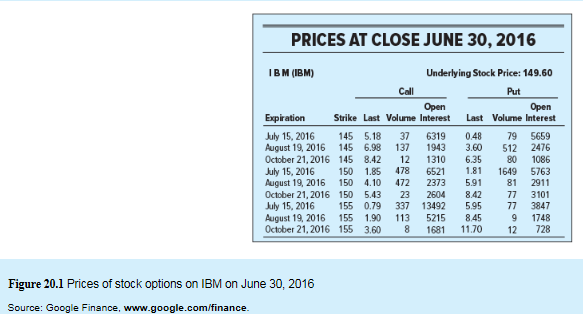
Let us calculate the payoff when Call option X is $150 and stock price on expiry date is $150.
| Calculation of payoff in case of call option: | ||
| Position | Stock price > X | Stock price is less than or equal to X |
| Payoff to call holder | Stock price -X | 0 |
| Payoff to call writer | -(Stock price -X) | 0 |
Stock price at expiration is $150.
Exercise or Strike price X=$150.
So, let us now substitute the values in the above table. We get
| Calculation of payoff in case of call option | ||
| Position | Stock price > X | Stock price is less than or equal to X |
| Payoff to call holder |  | 0 |
| Payoff to call writer |  | 0 |
By the above calculation, it is observed that the call writer is prepared to bear the risk in return of option premium as there is loss if stock price increases.
Calculation of profit for investment:

But as per the information given to us, the price of the call option is $1.85 at a strike price $150 on June 2016.

Therefore, the call buyer will incur loss of -$1.85.
d.
To compute: The payoff and the profit for investments when the put option’s exercise price X=$150 assuming that the stock price on the expiration date is $150.
Introduction:
Options: Options are the instruments used in financial transactions. These are derived based on the value of the underlying assets. Normally, the purpose of an option is to provide the buyer an opportunity to buy or sell the underlying asset depending upon the type of contract they possess. There are two types of options- Call option and put option.
d.
Answer to Problem 5PS
The incurred by the put buyer will be -$1.81 when the exercise price is $150.
Explanation of Solution
The information given to us is as follows:
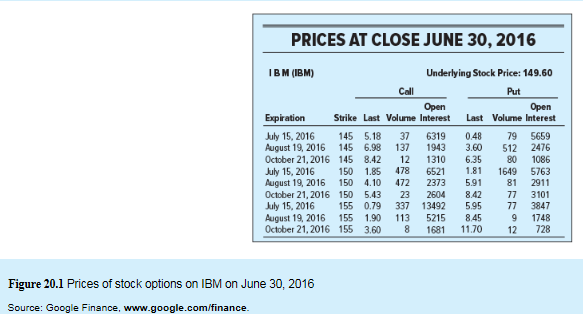
Let us calculate the payoff when Put option X is $150 and stock price on expiry date is $150.
| Calculation of payoff in case of a put option | ||
| Position | If Stock price is less than X | If Stock price is greater or equal to X |
| Payoff to Put holder | X-Stock price | 0 |
| Payoff to Put writer | -(X-Stock price) | 0 |
Stock price at expiration is $150.
Exercise or Strike price X=$150.
So, let us now substitute the values in the above table. We get
| Calculation of payoff in case of a put option | ||
| Position | If Stock price is less than X | If Stock price is greater or equal to X |
| Payoff to Put holder | $0 | 0 |
| Payoff to Put writer | $0 | 0 |

But, we are informed that the put option is $1.81 at a strike price of $150 on June 2016.

Therefore, the loss incurred by the buyer on put option will be -$1.81.
e.
To compute: The payoff and the profit for investments when the call option’s exercise price X=$155 assuming that the stock price on the expiration date is $150.
Introduction:
Payoff: In financial terminology, payoff refers to the return on an investment.
e.
Answer to Problem 5PS
The loss incurred by the call buyer will be -$0.79 when the exercise price is $155.
Explanation of Solution
The information given to us is as follows:
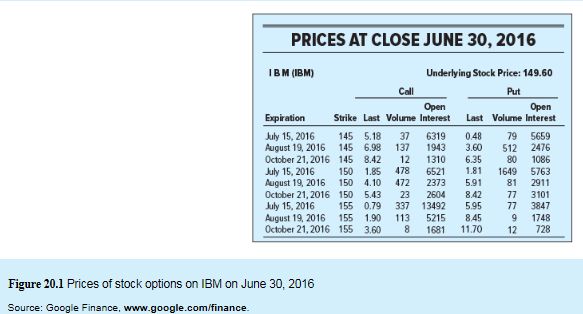
Let us calculate the payoff when Call option X is $155 and stock price on expiry date is $150.
| Calculation of payoff in case of call option | ||
| Position | Stock price > X | Stock price is less than or equal to X |
| Payoff to call holder | Stock price -X | 0 |
| Payoff to call writer | -(Stock price -X) | 0 |
Stock price at expiration is $150.
Exercise or Strike price X=$155.
So, let us now substitute the values in the above table. We get
| Calculation of payoff in case of call option | ||
| Position | Stock price > X | Stock price is less than or equal to X |
| Payoff to call holder | 0 | 0 |
| Payoff to call writer | 0 | 0 |
By the above calculation, it is observed that the call writer is prepared to bear the risk in return of option premium as there is loss if stock price increases.
Calculation of profit for investment

But as per the information given to us, the price of the call option is $0.79 at a strike price $155 on June 2016.

Therefore, the call buyer will incur loss of -$0.79.
f.
To compute: The payoff and the profit for investments when the put option’s exercise price X=$155 assuming that the stock price on the expiration date is $150.
Introduction:
Loss on investment: Investments are supposed to be considered as a monetary asset. Investments are done with an expectation to earn good income in future or to sell this asset at a higher price. If the purchase price of the asset is less than the sale price of the asset, it can be termed as profit on investment else it is loss on investment.
f.
Answer to Problem 5PS
The loss incurred by the put buyer will be $-0.95 when the exercise price is $155.
Explanation of Solution
The information given to us is as follows:
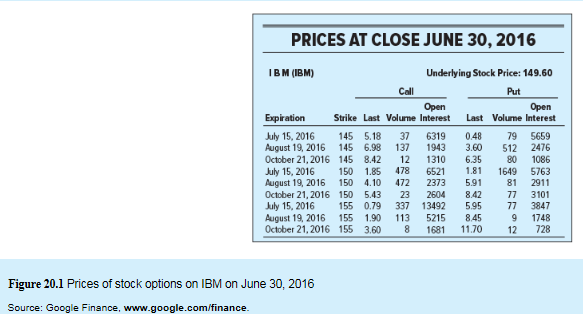
Let us calculate the payoff when Put option X is $155 and stock price on expiry date is $150.
| Calculation of payoff in case of a put option | ||
| Position | If Stock price is less than X | If Stock price is greater or equal to X |
| Payoff to Put holder | X-Stock price | 0 |
| Payoff to Put writer | -(X-Stock price) | 0 |
Stock price at expiration is $150.
Exercise or Strike price X=$155.
So, let us now substitute the values in the above table. We get
| Calculation of payoff in case of a put option | ||
| Position | If Stock price is less than X | If Stock price is greater or equal to X |
| Payoff to Put holder |  | 0 |
| Payoff to Put writer |  | 0 |

But, we are informed that the put option is $5.95 at a strike price of $155 on June 2016.

Therefore, the loss incurred by the buyer on put option will be -0.95.
Want to see more full solutions like this?
Chapter 20 Solutions
Investments, 11th Edition (exclude Access Card)
- PLEASE ANSWER THE COLUMN FULLY AND CORRECTLY PLEASE DO THE RIGHT CALCULATION DOUBLE CHECK AS WELL TO GIVE ME THE RIGHT ANSWER REQUIRED: Given the following information, what are the NZD/SGD currency against currency bid-ask quotations? Note: Do not round intermediate calculations. Round your answers to 4 decimal places. Bank Quotations American Terms European Terms Bid Ask Bid Ask New Zealand dollar 0.733 0.7340 1.3870 1.3884 Singapore dollar 0.6186 0.6191 1.6423 1.6436 answer Bid Ask New Zealand dollar ? ? Singapore dollar ? ?arrow_forwardAbout this Assignment For the Corporate Finance 301 assignment, you will submit a research paper that analyzes and discusses organizational financial risks. You will apply knowledge acquired in the course and use the concepts of multiple financial risks as the basis of research and analysis. The research paper should follow APA formatting style. Audience: upper-level business students. Project Prompt Write a 1,000-1,200-word analysis discussing financial risk concepts and assess the impact of the different financial risks on an organization. For this assignment, you will structure your assignment using four research paper sections associated with corporate risk management, as studied in the course. Base your research paper on the financial statements analyzed in Corporate Finance 301 assignment 2 and apply the knowledge acquired in the analysis. Define each financial risk, discuss the risk associated components, and evaluate the financial risks and how they affect the corporation's…arrow_forwardBobby Nelson, made deposits of $880 at the end of each year for 6 years. Interest is 6% compounded annually. What is the value of Bobby’s annuity at the end of 6 years?arrow_forward
- 1. Find the future value if $1,250 is invested in Simple interest account paying 6.5%: a. for 5 years b. for 20 years 2. Find the future amount $ 35,000 is invested for 30 years at 4.25% compounded: a. annually b. Quarterly c. monthly d. weekly 3. How much should be put into an account today that pays 7.75% compounded monthly if you need $10,000 in 5 years. 4. Find the effective rate for: a. 5.75% compounded quarterly b. 6.25% compounded daily. 5. $50 is invested at the end of each month into an account paying 7.5% compounded monthly. How much will be in the account after 5 years?…arrow_forwardSolve step by step no aiarrow_forwardDont use ai solve itarrow_forward
 Essentials Of InvestmentsFinanceISBN:9781260013924Author:Bodie, Zvi, Kane, Alex, MARCUS, Alan J.Publisher:Mcgraw-hill Education,
Essentials Of InvestmentsFinanceISBN:9781260013924Author:Bodie, Zvi, Kane, Alex, MARCUS, Alan J.Publisher:Mcgraw-hill Education,

 Foundations Of FinanceFinanceISBN:9780134897264Author:KEOWN, Arthur J., Martin, John D., PETTY, J. WilliamPublisher:Pearson,
Foundations Of FinanceFinanceISBN:9780134897264Author:KEOWN, Arthur J., Martin, John D., PETTY, J. WilliamPublisher:Pearson, Fundamentals of Financial Management (MindTap Cou...FinanceISBN:9781337395250Author:Eugene F. Brigham, Joel F. HoustonPublisher:Cengage Learning
Fundamentals of Financial Management (MindTap Cou...FinanceISBN:9781337395250Author:Eugene F. Brigham, Joel F. HoustonPublisher:Cengage Learning Corporate Finance (The Mcgraw-hill/Irwin Series i...FinanceISBN:9780077861759Author:Stephen A. Ross Franco Modigliani Professor of Financial Economics Professor, Randolph W Westerfield Robert R. Dockson Deans Chair in Bus. Admin., Jeffrey Jaffe, Bradford D Jordan ProfessorPublisher:McGraw-Hill Education
Corporate Finance (The Mcgraw-hill/Irwin Series i...FinanceISBN:9780077861759Author:Stephen A. Ross Franco Modigliani Professor of Financial Economics Professor, Randolph W Westerfield Robert R. Dockson Deans Chair in Bus. Admin., Jeffrey Jaffe, Bradford D Jordan ProfessorPublisher:McGraw-Hill Education





